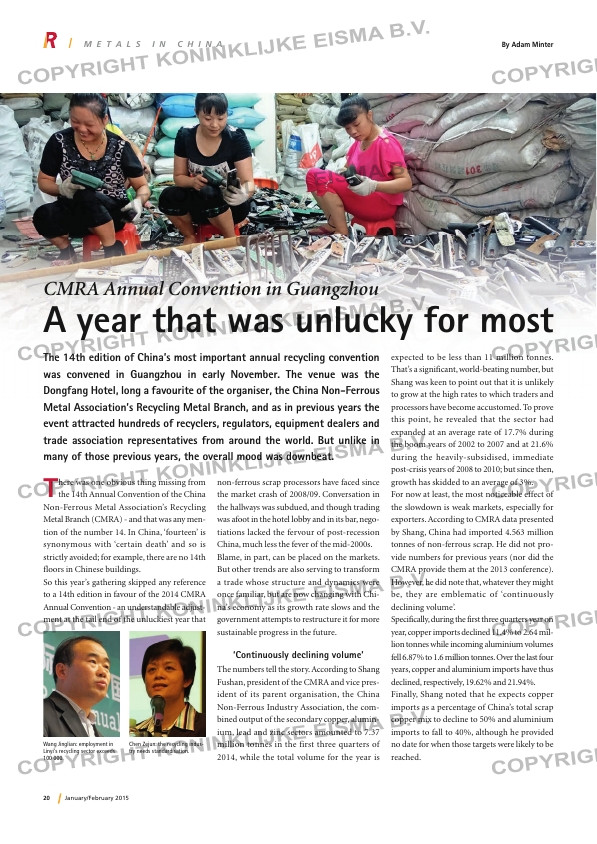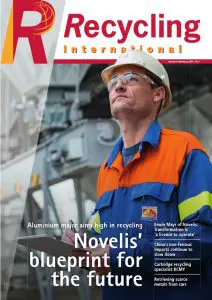Page 20 from: January / February 2015

20 January/February 2015
There was one obvious thing missing from the 14th Annual Convention of the China
Non-Ferrous Metal Association’s Recycling
Metal Branch (CMRA) – and that was any men-
tion of the number 14. In China, ‘fourteen’ is
synonymous with ‘certain death’ and so is
strictly avoided; for example, there are no 14th
floors in Chinese buildings.
So this year’s gathering skipped any reference
to a 14th edition in favour of the 2014 CMRA
Annual Convention – an understandable adjust-
ment at the tail end of the unluckiest year that
non-ferrous scrap processors have faced since
the market crash of 2008/09. Conversation in
the hallways was subdued, and though trading
was afoot in the hotel lobby and in its bar, nego-
tiations lacked the fervour of post-recession
China, much less the fever of the mid-2000s.
Blame, in part, can be placed on the markets.
But other trends are also serving to transform
a trade whose structure and dynamics were
once familiar, but are now changing with Chi-
na’s economy as its growth rate slows and the
government attempts to restructure it for more
sustainable progress in the future.
‘Continuously declining volume’
The numbers tell the story. According to Shang
Fushan, president of the CMRA and vice pres-
ident of its parent organisation, the China
Non-Ferrous Industry Association, the com-
bined output of the secondary copper, alumin-
ium, lead and zinc sectors amounted to 7.37
million tonnes in the first three quarters of
2014, while the total volume for the year is
expected to be less than 11 million tonnes.
That’s a significant, world-beating number, but
Shang was keen to point out that it is unlikely
to grow at the high rates to which traders and
processors have become accustomed. To prove
this point, he revealed that the sector had
expanded at an average rate of 17.7% during
the boom years of 2002 to 2007 and at 21.6%
during the heavily-subsidised, immediate
post-crisis years of 2008 to 2010; but since then,
growth has skidded to an average of 3%.
For now at least, the most noticeable effect of
the slowdown is weak markets, especially for
exporters. According to CMRA data presented
by Shang, China had imported 4.563 million
tonnes of non-ferrous scrap. He did not pro-
vide numbers for previous years (nor did the
CMRA provide them at the 2013 conference).
However, he did note that, whatever they might
be, they are emblematic of ‘continuously
declining volume’.
Specifically, during the first three quarters year on
year, copper imports declined 11.4% to 2.64 mil-
lion tonnes while incoming aluminium volumes
fell 6.87% to 1.6 million tonnes. Over the last four
years, copper and aluminium imports have thus
declined, respectively, 19.62% and 21.94%.
Finally, Shang noted that he expects copper
imports as a percentage of China’s total scrap
copper mix to decline to 50% and aluminium
imports to fall to 40%, although he provided
no date for when those targets were likely to be
reached.
M E T A L S I N C H I N A By Adam Minter
Chen Zejun: the recycling indus-
try needs standardisation.
Wang Jinglian: employment in
Linyi’s recycling sector exceeds
100 000.
The 14th edition of China’s most important annual recycling convention
was convened in Guangzhou in early November. The venue was the
Dongfang Hotel, long a favourite of the organiser, the China Non-Ferrous
Metal Association’s Recycling Metal Branch, and as in previous years the
event attracted hundreds of recyclers, regulators, equipment dealers and
trade association representatives from around the world. But unlike in
many of those previous years, the overall mood was downbeat.
A year that was unlucky for most
CMRA Annual Convention in Guangzhou
RI1-CMRA.indd 20 21-01-15 15:07



